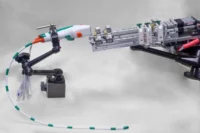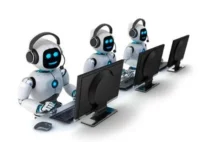Advances in artificially intelligent robots have enabled pioneering scientists to endow them with human-like capabilities. A new study by Cornell University researchers published in Science Advances introduces an autonomous, self-healing soft robot that is not only able to identify injuries but also heal itself. The scientists plan to integrate these soft robots with artificial intelligence (AI) machine learning in the future.
“We introduce an autonomous self-healing optical sensing mechanism, networks of self-healing light guides for dynamic sensing (SHeaLDS), which exploit the damage-resilient properties intrinsic to light propagation, in combination with an intrinsic self-healing material, to achieve an optomechanical sensor that both autonomously self-heals and provides reliable dynamic sensing performance,” wrote Rob Shepherd, associate professor of mechanical and aerospace engineering at Cornell, in collaboration with Young Seong Kim and Hedan Bai.
The soft robot consists of a flexible material called poly elastomer (polyurethane urea). The soft robot uses light for optical sensing instead of electrical signals for sensing, thus eliminating the need for mechanical contact. The team paired LED lights with fiber-optic sensors that are able to detect changes on the surface of the soft robot. The optomechanical sensor is damage-resilient and stretchable.
“Damage intelligence realized through SHeaLDS demonstrates autonomy in damage sensing, healing, and adaptation resembling physical intelligence in animals,” reported the researchers.
The robot is able to self-heal at room temperature because the poly elastomer is cross-linked with dynamic aromatic disulfide bonds to provide strength and hydrogen bonds for self-healing ability. The material contains many hydrogen bonds that add to the fast and autonomous self-healing.
“We demonstrate a damage-intelligent soft robot, enabled by SHeaLDS, that senses injury and self-heals from severe damage on the molecular level within minutes,” reported the scientists.
The researchers report that their robot material is elastic, transparent, and strong. The soft robot was then put to the test with real-world scenarios such as razor blade cuts and a hand saw.
“Combined with advances in artificial intelligence, SHeaLDS presents a route toward more enduring and adaptive robots,” the researchers concluded. “Beyond robotics, we envision SHeaLDS to find utility in the broader area where damage intelligence is essential in damage-prone environments, such as spacesuits and supersonic parachute monitoring in space, as well as applications where device longevity is preferred, such as wearables for human-machine interaction and digital health.”




GIPHY App Key not set. Please check settings